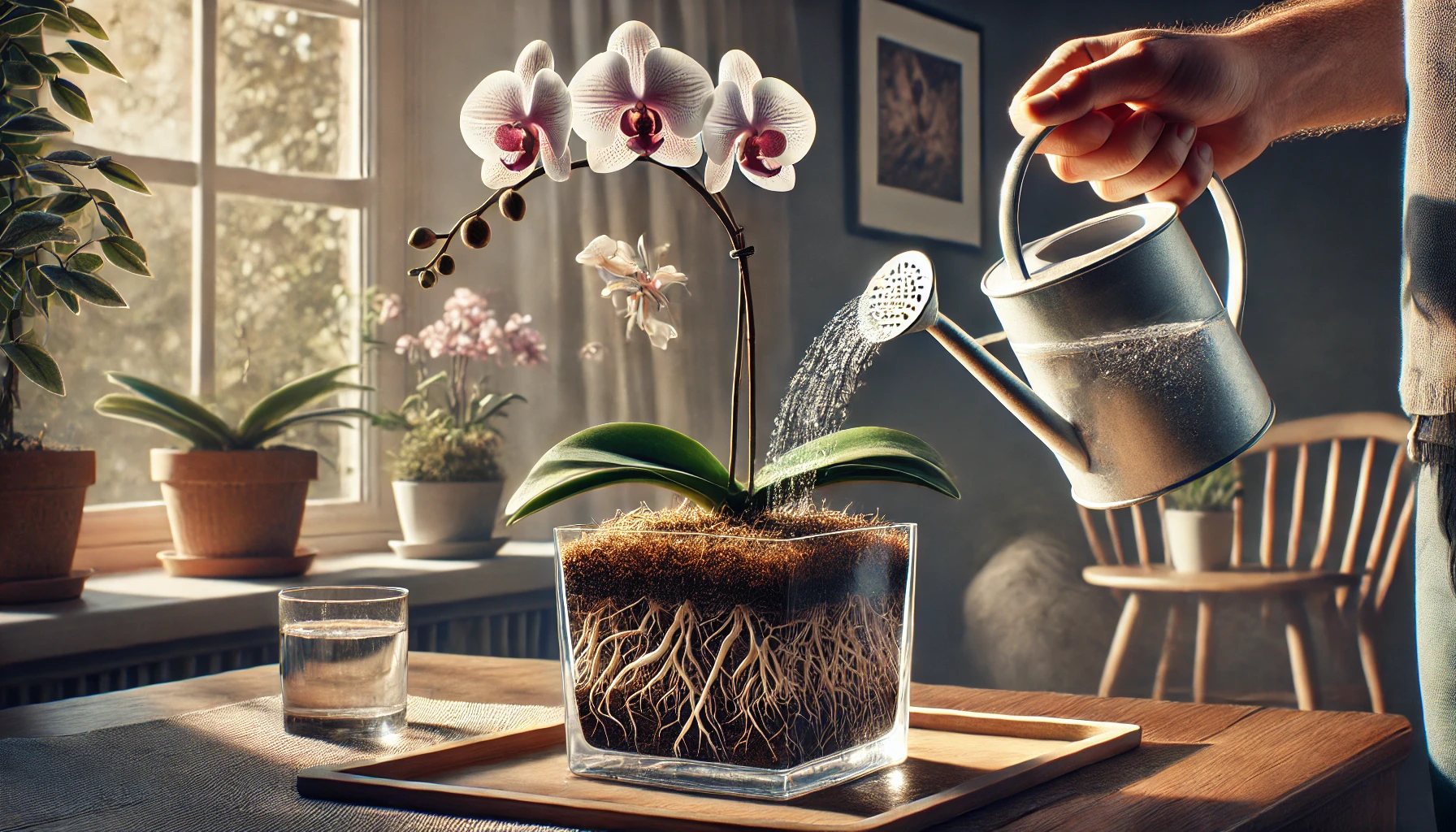Watering orchids correctly is one of the biggest challenges for growers. Unlike typical houseplants, orchids do not grow in soil, meaning they absorb moisture differently. Too much water can lead to root rot, while too little can cause dehydration and stunted growth. Learning how to maintain the right moisture balance is essential for keeping your orchid healthy and thriving.
🌱 Understanding How Orchids Absorb Water
In their natural environment, most orchids grow on trees with their roots exposed to rain, humidity, and air. Instead of absorbing water from the soil, they take in moisture from the air and the surface they are attached to. This is why orchids need a well-draining potting medium and a proper watering routine to mimic their natural conditions.
❌ Common Problems Caused by Incorrect Watering:
- Overwatering – Leads to root rot, mushy leaves, and a foul odor.
- Underwatering – Causes shriveling roots, weak leaves, and slow growth.
- Watering at the wrong time – Watering in the evening can cause excess moisture to sit overnight, leading to fungal infections.
✔ Signs of a Properly Hydrated Orchid:
- Firm, light green leaves
- Plump, green or silvery-white roots
- Healthy new growth (new leaves, roots, or flower spikes)
💧 How Often Should You Water an Orchid?
There is no one-size-fits-all answer to how often orchids should be watered, as it depends on temperature, humidity, potting medium, and pot type. However, a general guideline is:
- Summer: Water once or twice a week (depending on heat and humidity).
- Winter: Water every 7 to 10 days, as orchids need less moisture during dormancy.
- Low-humidity environments: Water more frequently to prevent dehydration.
- High-humidity environments: Water less frequently to avoid excess moisture buildup.
💡 Best practice: Always check the roots before watering. If the roots are silvery-white, it’s time to water. If they are still green, wait a few more days.
🏺 Choosing the Right Pot and Potting Medium for Proper Hydration
The type of pot and growing medium you use directly affects how much water your orchid retains.
✔ Best pots for moisture control:
- Plastic pots retain moisture longer, reducing the need for frequent watering.
- Clay or terracotta pots absorb excess moisture, preventing overwatering.
- Transparent pots allow for easy monitoring of root health and dryness.
✔ Best potting mediums for hydration balance:
- Bark chips – Provide excellent drainage while holding minimal moisture.
- Sphagnum moss – Retains more water, great for orchids in drier climates.
- Coconut husk – Holds moderate moisture and decomposes slowly.
- Perlite and charcoal – Help with aeration and prevent excess moisture retention.
✔ How to choose the right mix:
- If your orchid dries out too quickly, mix sphagnum moss with bark to improve moisture retention.
- If your orchid stays wet for too long, switch to larger bark chips for better drainage.
🛠 Best Watering Techniques for Orchids
💦 Method 1: Soaking (Best for Most Orchids)
✔ Place the orchid pot in a bowl of room-temperature water.
✔ Let the roots absorb moisture for 5 to 10 minutes.
✔ Remove the pot and let excess water drain completely.
✔ Avoid letting water collect in the crown (the center of the leaves).
🚿 Method 2: Running Water (Quick and Effective)
✔ Take the orchid to a sink and run lukewarm water over the roots for about 30 seconds.
✔ Let all excess water drain before placing the plant back in its spot.
🧊 Method 3: Ice Cube Watering (Not Recommended)
❌ Ice cubes shock the roots and do not provide enough moisture.
❌ Orchids are tropical plants and should never be exposed to cold water.
🌡 How Temperature and Humidity Affect Watering Needs
Orchids thrive in temperatures between 65–75°F (18–24°C) during the day and slightly cooler at night. Their watering needs increase in warm temperatures and decrease in cold conditions.
✔ High temperatures (above 80°F/27°C): Increase watering to twice a week.
✔ Cool temperatures (below 60°F/15°C): Reduce watering to once every 10 days.
✔ Low humidity (below 40%): Mist the roots or place the orchid on a humidity tray to prevent dehydration.
✔ High humidity (above 70%): Ensure good airflow to prevent fungal infections.
⚠ Avoid Watering Mistakes That Harm Orchids
❌ Overwatering: Causes root rot, yellow leaves, and bacterial infections. Always let roots dry slightly between waterings.
❌ Underwatering: Leads to wrinkled leaves and slow growth. Soak the plant if roots become shriveled.
❌ Watering late in the day: Moisture sitting overnight encourages fungal infections. Always water in the morning.
❌ Using cold or chlorinated water: Room-temperature filtered or rainwater is best for orchids.
🛡 How to Maintain Hydration Without Overwatering
✔ Use a humidity tray: Place the orchid on a shallow tray filled with water and pebbles to increase moisture without soaking the roots.
✔ Misting (only when needed): If the air is too dry, lightly mist the roots but avoid misting the leaves too often.
✔ Check root color: Water only when the roots turn silvery-white, not when they are still green.
✔ Improve airflow: Prevent excess moisture buildup by keeping the orchid in a well-ventilated area.
🌿 Final Tips for Proper Orchid Hydration
✔ Water in the morning to allow excess moisture to evaporate.
✔ Always use pots with drainage holes to prevent water from sitting in the bottom.
✔ Let roots dry slightly between waterings to avoid rot.
✔ Adjust watering based on climate, temperature, and humidity.
✔ Avoid using cold water or ice cubes, as orchids prefer warm, tropical conditions.
Mastering the art of watering orchids will keep their roots strong, their leaves vibrant, and their blooms long-lasting. 🌸✨
